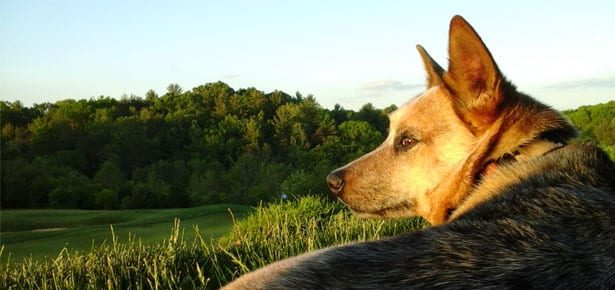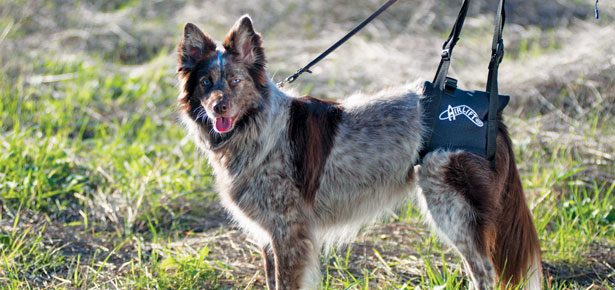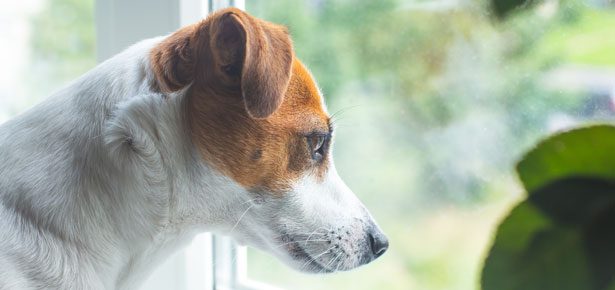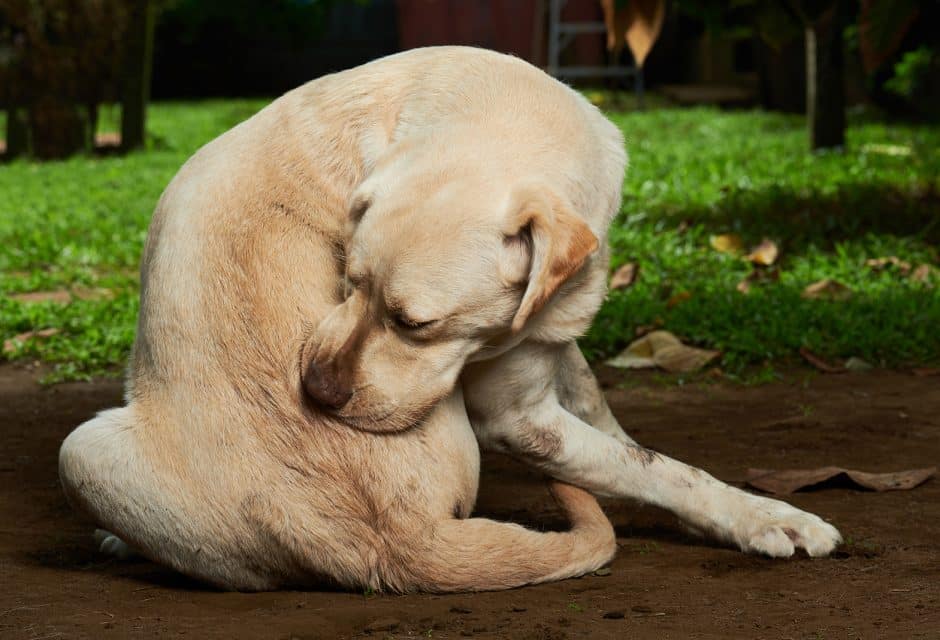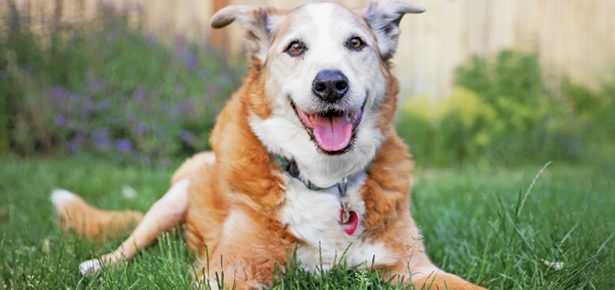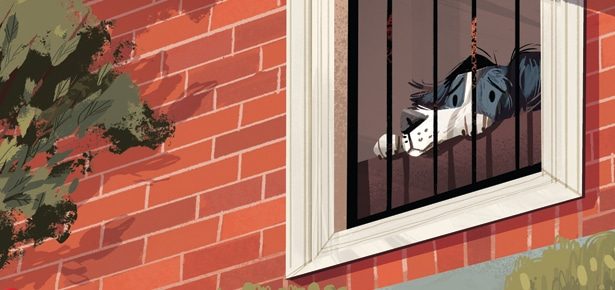
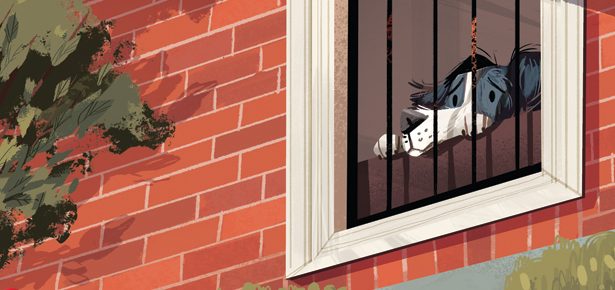
Is Your Dog Stressed or Depressed?
4 Ways to Solve Stress & Depression in Dogs
A hundred years ago, most dogs herded, hunted, guarded, ratted or tracked much of the day, then ate scraps for dinner before retiring for the evening, sleeping either outside or in a cold kennel with other dogs. They rarely saw the veterinarian and often didn’t even see the inside of a home. Life was utilitarian; they had jobs, and any affection or leisure time came as payback for a job well done.
Today, most dogs are treated as companions and as family members. They eat balanced diets, visit parks, spend much of their days in the home, and visit the veterinarian and groomer regularly. Life spans for most dogs have nearly doubled since last century. They go to doggie daycare and dog parks, have boxes of toys, and sleep on cushy dog beds. Compared to dogs a century ago, life is pretty cushy.
Or is it?…
The Good Old Days Though life was harder a century ago, dogs back then were better able to express their canine instincts on a daily basis. Instead of living in an apartment or in a small home with a tiny yard, they lived on farms or in rural areas that allowed for running, exploring, chasing, hunting vermin, and socializing with other dogs. Canine obesity was unheard of among such active animals. Behavioural and environmental enrichment, a term used today to describe techniques to reduce dog boredom, was never needed. Dogs were engines of purpose and never got bored.
Modern Day Pressures Today’s dogs, though better cared for and treated with more respect, are under pressures that dogs of old never dreamed of. Denied the chance to express their innate drives and abilities, they often languish and feel discontented. They internalize their frustrations, which can translate to undesirable behaviours, like tearing apart the couch or excessive barking.
In addition to boredom and lack of exercise, today’s dogs are more isolated than their predecessors. They generally leave their litters at eight weeks then have only transitory contact with other dogs from that moment on. (Puppies should not leave the litter until at least 12 weeks of age.) Most families have only one dog, which spends much of his day in the home or yard, with little socialization. This isolation is one reason why trainers see much more antisocial behaviour among dogs today. Dogs are meant to be social creatures; unfortunately, many today live more like cats than canines.
When today’s dogs do get socialized with other dogs, it is often in an excessive manner, at a dog park or doggie daycare, with too many strange dogs—dogs who, more likely than not, have also lived a life of isolation. Instead of being an enriching experience, it becomes a study in stress and contention. Add in the bustle and noise of urban life and you begin to see that modern dog-life might not compare all that well with days of yore. So what’s a dog lover to do?
1. Avoid Overpopulated Dog Parks or Hectic Doggie Daycares
Contrary to popular belief, most dogs do not enjoy being thrown into a mob of strange, pushy or fearful dogs. They prefer to instead be with a group of dogs they know and trust. Overcrowded daycares can be even worse than parks, as the space is smaller, allowing a “critical mass” of tension to develop. Many dogs can take days to recover from such “play.” Instead, visit a dog park with a low population of easygoing dogs that your dog tolerates. Or find a daycare that monitors a maximum of six to eight dogs in a large room (at least 1000 square feet), all of similar congenial temperament. More social, outgoing, boisterous dogs many be just fine in a more crowded park or daycare situation—it’s all about knowing your dog. If your dog is running about, visiting all the dogs, and waving his tail like a flag, he’s having a great time. Tail clamped and hiding behind yours legs? Not so much.
2. The Right Social Environment: Creating a Clan for Your Dog
Canines are very social animals, but usually only with those they know, or with those they feel present no danger. There is a clannish sense among dogs; they feel safe with their “kinfolk,” but will often be uncomfortable around strangers (canine and human alike). It’s up to you to create that “clan” for your dog. Try the following:
A. Two dogs are often better than one, and will keep each other company while you are gone.
The younger dog gets to see the older, “mentor” dog in action; housetraining, obedience, and the overall home routine are all learned more quickly through modeling. So if possible, consider getting your four- or five-year-old dog a friend. Avoid getting two puppies at the same time, however, as the mentoring effect won’t take place, and you will be burdened with teaching two puppies instead of one.
B. Find your dog local dog-friends.
Having a calm, friendly neighbourhood dog come over for regular play visits will perk up her day and help her to satisfy her innate social needs. Build up a “clan” of local dogs and interact with them on walks, at parks, and around the home.
C. Go on group walks with three or four other dogs and their people.
Called a “directed walk,” it should be less of a social event and more of a “mission” in the dogs’ minds. They are out with a few trusted others, patrolling the sidewalks, exploring smells, sharing the experience. This builds a lasting sense of camaraderie, and a real sense of dog community. It’s one of the best things you can do to enrich and inspire your dog.
D. To the park!
If your dog is well mannered and confident around other dogs, take her to a well-managed dog park with a reasonable number of dogs in a large enough space. Avoid parks with too high a density of dogs; try for no more than fifteen dogs per acre (about the size of a soccer field). Spirited play is fine, but be cautious of dogs who play too rough or who seem to be on the verge of aggression. The key is to find a park with regular visitors who you become familiar with and whose dogs appear balanced, confident, and eager to play.
3. Training, Training, Training!
Give your dogs something to think about and do by teaching them to perform meaningful actions. Daily training sessions (even five minutes!) not only improves your relationship and your bond, it also contributes to fulfilling your dog’s need to think and perform a job.
4. Boredom Relieving Activities
You’ve filled in your dog’s social calendar. Now it’s time to create activities designed to stimulate your dog’s mind and body. Try:
A. Trick Training
Basic obedience is necessary, but tricks are where the fun is! So, every month, teach your dog one new trick. By teaching your dog new tricks on a regular basis, you will be increasing her repertoire of behaviours and expanding her mind. You will literally be creating new neural connections in her brain, making her smarter and happier. And trick training is completely positive and a great
way to bond.
The basic tenants of training are “capturing” a behaviour—waiting until your dog spontaneously performs the action you’re looking for, then rewarding—or “shaping”, where you encourage your dog to do something by luring her into a position with a
treat or toy.
B. Enrichment Techniques
In and around your home, try to make your dog’s environment as stimulating and fun as possible. Have toys and chews on hand. Provide food dispenser toys packed with treats around the home when you leave to get your dog to problem solve and self-reward. Hide a few small treats around the home to stimulate her nose and hunger drive. Drop a frozen, low-sodium chicken broth cube into her food dish. When home, play fetch or hide-and-seek games outside. While in the yard, give her a whole uncooked egg and see if she can figure out how to get the prize inside!
C. Exercise
No matter the size or age of your dog, find daily activities to share. For most dogs, the absolute minimum is a half an hour walk, morning and night. For many dogs though, particularly those that are young and athletic, this won’t be nearly enough. Turn to page 74 for ideas to maximize the exercise your dog gets if time is of
a premium.
D. Classes
Dogs have many potential skills that go unused. Consider tapping into these hidden talents by taking classes. Obedience, tracking, agility, herding, or flyball classes are just a few you can consider. In addition to your dog learning new skills and expressing her innate abilities, she will get plenty of exercise, and make new dog friends in the process.
Tailor what type of class you choose according to your dog’s personality and energy levels. If she is a bundle of energy or hyper-focused, consider an agility class, with lots of running, and complex task solving. If she is constantly sniffing around the home, take a tracking class, and put that nose to good use. Shy or independent-minded? Try a tricks class, where learning fun new behaviours will boost confidence, all in a laid-back atmosphere that doesn’t require interaction with other dogs. Social butterfly? Choose a social skills class that encourages controlled interactions with other sociable dogs. Crazy to fetch? Take a flyball class, where your dog can retrieve a ball to her heart’s content.
Though today’s dogs may no longer have to work for a living, it doesn’t mean they can’t still lead productive, fulfilling lifestyles, filled with activities and stimuli that enrich, teach, and satisfy. The key is offering opportunities for engagement, mental stimulation, and enough exercise. By trying some of the above techniques, you will be well on your way to eliminating modern day pressures from your dog’s life. She will be healthier, smarter, trimmer, and more confident. And so will you!
Join the newsletter and never miss out on dog content again!
"*" indicates required fields
By clicking the arrow, you agree to our web Terms of Use and Privacy & Cookie Policy. Easy unsubscribe links are provided in every email.

